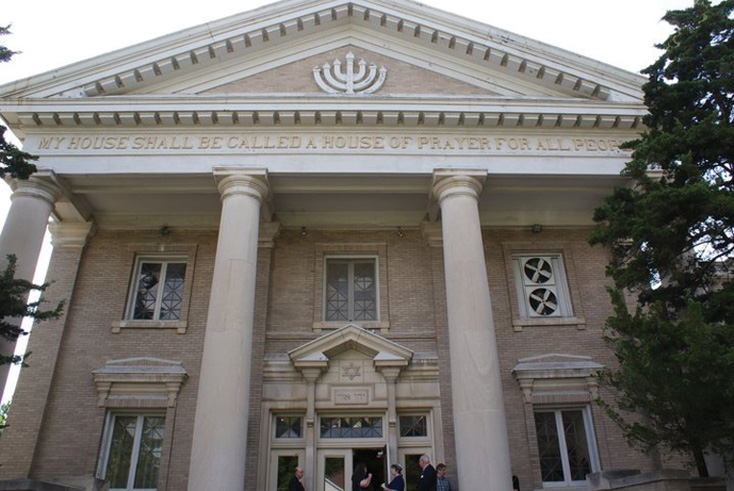For a number of years, the Jewish population has been dwindling in St. Joseph, Missouri. In 1919, there were 3,300 Jews who made their home there according to the “Directory of Jewish Local Organizations in the United States.”
Today there are fewer than 100 and not all of them are affiliated with a synagogue said Richard Schwarz, Ph.D., president of the Reform synagogue, Temple Adath Joseph.
Because of dwindling attendance on Shabbat, for the past two years the only two synagogues in St. Joseph have been alternating Shabbat services at Temple Adath Joseph — the first two weeks are Conservative and the other weeks in the month are Reform. Reform Rabbi Linda Steigman holds services once a month.
“We realized early on that we were both having problems getting a good attendance and it’s a shame to have two services going on,” said Bob Ott, president of the Conservative Temple B’nai Sholem. “We got together and determined there had to be a way we could work it out so it would be beneficial to both of us.”
Now more changes are coming to St. Joseph. B’nai Sholem sold its building in April, but they’re not disbanding by any means.
Alternating Shabbat services have allowed the two synagogues to see the similarities as well as the differences in their services, and to appreciate both, Ott pointed out.
Between the two synagogues, attendance on Friday night has been anywhere from a half dozen to a couple of dozen, he said.
Adath Joseph’s Schwarz said when he came to St. Joseph in 1976 it wasn’t unusual for them to have 150 to 200 people at a service, particularly for the High Holidays.
Ott said at its peak, B’nai Sholem had several hundred congregants. Temple B’nai Sholem was founded in 1960 as the result of a merger between Shaare Sholem and B’nai Yaakov synagogues.
The Conservative president said the building was more than they needed. Its chapel seats about 40 and the main sanctuary seats 400-500 people, which makes it the perfect venue for the buyer — Robidoux Resident Theatre — not just for the seating but other amenities as well. The building has parking on the grounds; it’s not far from downtown from downtown; there’s classroom space; a chapel, which will be good for a practice stage area; and a hall downstairs for dinners.
“It was just kind of everything they needed in one spot and they’re going to call it the Ruby Theatre,” Ott said. “So it’s kind of a gem you could say. The building is still there and we get to enjoy it in a slightly different venue, but we’ll still get to see our old haunt.”
Visit the theater’s website at rrtstjoe.org to see photos of the renovation from a synagogue to a theater.
The live theater group wanted the inside of the building to stay pretty much the same, including the fixtures and seating, which are all individual padded arm chairs.
When B’nai Sholem began alternating services at Adath Joseph, Ott said someone would be at the building maybe two hours a month, and there were maintenance and vandalism concerns. If a toilet was running and no one was there to notice, they would end up with huge water and sewer bills. Or there could have been theft of air conditioning units and other types of vandalism.
“It was just hard to maintain without someone being there on a regular basis,” said Ott. “That’s the nice thing about this theater group buying it; there’s going to be somebody there every day, so maintenance will be less of an issue because they can stay on top of the minor things before they become major.”
The sale became effective the middle of April this year. Ott said he believes the Ruby Theatre will hold its first production in about two months.
A blending
For High Holidays this year, the two temples are blending their services.
“We felt we were coming to this point where we’re at now, regardless of whether the building sold, to do something joint — as a High Holy Day service,” Ott said.
The Reform machzor, “Gates of Repentance,” will be used at all the services, but they’ll be bringing in some Conservative traditions said Rabbi Steigman. She and Ott sat down and went page by page through the Reform and Conservative prayer books.
“We’ve both tried to understand where the other is coming from and really work on making the service the most meaningful for everybody,” Rabbi Steigman said. “It’s been a pleasure working with Bob doing that. I have a lot of respect for him and how he’s handled the whole thing.
“It’s a lot of extra work to make this happen, but I think if we can bring people together and help them realize that we are so much more alike than we are different, it will be just wonderful.”
The biggest shock for all the congregants, she said, will be the music. Reform is used to having a choir with an organist. Conservatives don’t use musical accompaniment. So for three of the High Holiday services there will be an organ and for the other three there will not.
Ott too said Conservatives don’t particularly appreciate an organ as being a central part of the service because they’re a cappella.
“But we’re bringing both in so hopefully everybody gets something and everybody will be happy when they walk away,” he said. “It’s something we knew we had to do as a community because we’re just getting to the point where we don’t have that many people left and this was a kismet opportunity.”
Rabbi Steigman said because congregants have been coming together for Shabbat services for two years, she believes there’s a willingness on their part to be accepting. For those who haven’t been attending regularly, it may take them a little longer to get used to it.
“I hope people don’t throw up a wall of resistance automatically and say this is not the way we usually pray, because what we’re really doing is trying to come together and preserve what’s left of Judaism in St. Joseph,” she said. “I think together, rather than separate, we can be stronger.”
Ott agreed. “I wouldn’t say we struggle; I think each in our own right we had something solid, but it certainly is much more impressive when you’ve got a larger group that embraces what you’re doing,” he said.
Rabbi Steigman said there’s a fondness that has built up between the congregants who have been attending Friday night services, which will be helpful in the process of coming together for the High Holiday services.
“Also, the Conservative synagogue has not had a rabbi in a long time and has not had anybody who has been able to read from the Torah scroll, so that will be something new for them this year because I will do all the reading from the Torah,” she said. “I think that that’s really one of the important things to do.”
At first the assumption was for B’nai Sholem to do some of the High Holiday services and Adath Joseph to do the others. “But Bob said he thought it was important, and he was absolutely right, that we do each service together,” said Rabbi Steigman. “I thought that was such a wonderful way to look at it.”
Schwarz anticipates having up to 100 congregants at evening services, but said it would likely drop to half that for morning services.
What’s next for B’nai Sholem?
Ott said the board decided to wait until after the High Holidays to make any decisions on what B’nai Sholem’s next move will be. They want to see what the general reaction is to the blended High Holiday services before looking at their options.
They may start looking for another permanent building or rent someone else’s space as they’re doing now.
“Obviously what we’re worried about is losing our identity by becoming associated with Temple Adath Joseph and Temple Adath Joseph alone,” Ott said. “Nothing against them, but this is not a merger and it’s not an absorption; right now it’s a blending with distinct identity, and how we maintain our identity, assuming we do, is the next stage.”
He said the board is interested in seeing what happens with this major shift. Will they retain their congregants? Are they tied to Conservative Judaism and the leadership or were they tied to a building where the only reason they came back was to pray in a familiar place that holds memories for them?
“If that’s what it’s about and they don’t follow through and come to the High Holy Day services this year, then we have to analyze that,” he said. “In general I think this is a good thing for the Jewish community of St. Joseph and how good it is we’ll know [in a couple of weeks].”



